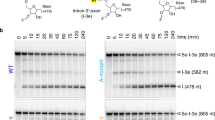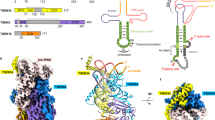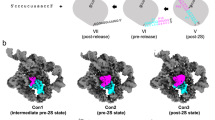Abstract
Group II introns are self-splicing ribozymes that excise themselves from precursor RNAs and catalyze the joining of flanking exons. Excised introns can behave as parasitic RNA molecules: they can catalyze their own insertion into DNA and RNA via a reverse splicing reaction. Previous studies have identified mechanistic roles for various functional groups located in the catalytic core of the intron and within target molecules. Here we introduce a new method for synthesizing long RNA molecules with a modified nucleotide at the 3′ terminus. This modification allows us to examine the mechanistic role of functional groups adjacent to the reaction nucleophile. During reverse splicing, the 3′-OH group of the intron terminus attacks the phosphodiester linkage of spliced exon sequences. Here we show that the adjacent 2′-OH group on the intron terminus plays an essential role in activating the nucleophile by stripping away a proton from the 3′-OH and then shuttling it from the active site.
This is a preview of subscription content, access via your institution
Access options
Subscribe to this journal
Receive 12 print issues and online access
$259.00 per year
only $21.58 per issue
Buy this article
- Purchase on Springer Link
- Instant access to full article PDF
Prices may be subject to local taxes which are calculated during checkout




Similar content being viewed by others
References
Pyle, A.M. & Lambowitz, A.M. Group II introns: ribozymes that splice RNA and invade DNA. in The RNA World (eds. Gesteland, R.F., Cech, T.R. & Atkins, J.F.) 469–505 (Cold Spring Harbor Laboratory Press, Cold Spring Harbor, New York, USA, 2006).
Vallès, Y., Halanych, K.M., Boore, J.L. & Group, I.I. Introns break new boundaries: presence in a bilaterian′s genome. PLoS One 3, e1488 (2008).
Pyle, A.M. Group II introns: catalysts for splicing, genomic change and evolution. in Ribozymes and RNA Catalysis (eds. Lilley, D.M.J. & Eckstein, F.) 201–228 (RCS Publishing, Cambridge, UK, 2008).
de Lencastre, A., Hamill, S. & Pyle, A.M. A single active-site region for a group II intron. Nat. Struct. Mol. Biol. 12, 626–627 (2005).
Toor, N., Keating, K.S., Taylor, S.D. & Pyle, A.M. Crystal structure of a self-spliced group II intron. Science 320, 77–82 (2008).
Toor, N., Rajashankar, K., Keating, K.S. & Pyle, A.M. Structural basis for exon recognition by a group II intron. Nat. Struct. Mol. Biol. 15, 1221–1222 (2008).
Dai, L. et al. A three-dimensional model of a group II intron RNA and its interaction with the intron-encoded reverse transcriptase. Mol. Cell 30, 472–485 (2008).
Daniels, D.L., Michels, W.J. Jr. & Pyle, A.M. Two competing pathways for self-splicing by group II introns: a quantitative analysis of in vitro reaction rates and products. J. Mol. Biol. 256, 31–49 (1996).
Chu, V.T., Liu, Q., Podar, M., Perlman, P.S. & Pyle, A.M. More than one way to splice an RNA: branching without a bulge and splicing without branching in group II introns. RNA 4, 1186–1202 (1998).
Podar, M., Perlman, P.S. & Padgett, R.A. The two steps of group II intron self-splicing are mechanistically distinguishable. RNA 4, 890–900 (1998).
Roitzsch, M. & Pyle, A.M. The linear form of a group II intron catalyzes efficient autocatalytic reverse splicing, establishing a potential for mobility. RNA 15, 473–482 (2009).
Aizawa, Y., Xiang, Q., Lambowitz, A.M. & Pyle, A.M. The pathway for DNA recognition and RNA integration by a group II intron retrotransposon. Mol. Cell 11, 795–805 (2003).
Roitzsch, M. Group II introns. in Wiley Encyclopedia of Chemical Biology vol. 2 (ed. Begley, T.P.) 232–239 (John Wiley & Sons, Hoboken, New Jersey, USA, 2008).
Padgett, R.A., Podar, M., Boulanger, S.C. & Perlman, P.S. The stereochemical course of group II intron self-splicing. Science 266, 1685–1688 (1994).
Gordon, P.M. & Piccirilli, J.A. Metal ion coordination by the AGC triad in domain 5 contributes to group II intron catalysis. Nat. Struct. Biol. 8, 893–898 (2001).
Podar, M., Perlman, P.S. & Padgett, R.A. Stereochemical selectivity of group II intron splicing, reverse splicing, and hydrolysis reactions. Mol. Cell. Biol. 15, 4466–4478 (1995).
Sontheimer, E.J., Gordon, P.M. & Piccirilli, J.A. Metal ion catalysis during group II intron self-splicing: parallels with the spliceosome. Genes Dev. 13, 1729–1741 (1999).
Gordon, P.M., Fong, R. & Piccirilli, J.A. A second divalent metal ion in the group II intron reaction center. Chem. Biol. 14, 607–612 (2007).
Steitz, T.A. & Steitz, J.A. A general two-metal-ion mechanism for catalytic RNA. Proc. Natl. Acad. Sci. USA 90, 6498–6502 (1993).
Griffin, E.A. Jr., Qin, Z., Michels, W.J. Jr. & Pyle, A.M. Group II intron ribozymes that cleave DNA and RNA linkages with similar efficiency, and lack contacts with substrate 2′-hydroxyl groups. Chem. Biol. 2, 761–770 (1995).
Gordon, P.M. et al. New strategies for exploring RNA′s 2′-OH expose the importance of solvent during group II intron catalysis. Chem. Biol. 11, 237–246 (2004).
Huang, Z. & Szostak, J.W. A simple method for 3′-labeling of RNA. Nucleic Acids Res. 24, 4360–4361 (1996).
Milligan, J.F., Groebe, D.R., Witherell, G.W. & Uhlenbeck, O.C. Oligoribonucleotide synthesis using T7 RNA polymerase and synthetic DNA templates. Nucleic Acids Res. 15, 8783–8798 (1987).
Kao, C., Rüdisser, S. & Zheng, M. A simple and efficient method to transcribe RNAs with reduced 3′ heterogeneity. Methods 23, 201–205 (2001).
Astatke, M., Ng, K., Grindley, N.D. & Joyce, C.M. A single side chain prevents Escherichia coli DNA polymerase I (Klenow fragment) from incorporating ribonucleotides. Proc. Natl. Acad. Sci. USA 95, 3402–3407 (1998).
Pyle, A.M., Chu, V.T., Jankowsky, E. & Boudvillain, M. Using DNAzymes to cut, process, and map RNA molecules for structural studies or modification. Methods Enzymol. 317, 140–146 (2000).
Kuzmic, P. Program DYNAFIT for the analysis of enzyme kinetic data: application to HIV proteinase. Anal. Biochem. 237, 260–273 (1996).
Dunitz, J.D. & Taylor, R. Organic fluorine hardly ever accepts hydrogen bonds. Chem. Eur. J. 3, 89–98 (1997).
Aurup, H., Tuschl, T., Benseler, F., Ludwig, J. & Eckstein, F. Oligonucleotide duplexes containing 2′-amino-2′-deoxycytidines: thermal stability and chemical reactivity. Nucleic Acids Res. 22, 20–24 (1994).
Shan, S.O. & Herschlag, D. Probing the role of metal ions in RNA catalysis: kinetic and thermodynamic characterization of a metal ion interaction with the 2′-moiety of the guanosine nucleophile in the tetrahymena group I ribozyme. Biochemistry 38, 10958–10975 (1999).
Roitzsch, M., Anorbe, M.G., Sanz Miguel, P.J., Müller, B. & Lippert, B. The role of intramolecular hydrogen bonding on nucleobase acidification following metal coordination: possible implications of an “indirect” role of metals in acid-base catalysis of nucleic acids. J. Biol. Inorg. Chem. 10, 800–812 (2005).
Serjeant, E.P. & Dempsey, B. Ionization constants of organic acids in solution. in UPAC Chemical Data Series no. 23 (Pergamon Press, Oxford, UK, 1979).
Sigel, R.K., Vaidya, A. & Pyle, A.M. Metal ion binding sites in a group II intron core. Nat. Struct. Biol. 7, 1111–1116 (2000).
Yoshida, A., Shan, S., Herschlag, D. & Piccirilli, J.A. The role of the cleavage site 2′-hydroxyl in the Tetrahymena group I ribozyme reaction. Chem. Biol. 7, 85–96 (2000).
Oyelere, A.K., Kardon, J.R. & Strobel, S.A. pK(a) perturbation in genomic Hepatitis Delta Virus ribozyme catalysis evidenced by nucleotide analogue interference mapping. Biochemistry 41, 3667–3675 (2002).
Das, S.R. & Piccirilli, J.A. General acid catalysis by the hepatitis delta virus ribozyme. Nat. Chem. Biol. 1, 45–52 (2005).
Gordon, P.M., Sontheimer, E.J. & Piccirilli, J.A. Kinetic characterization of the second step of group II intron splicing: role of metal ions and the cleavage site 2′-OH in catalysis. Biochemistry 39, 12939–12952 (2000).
Weinger, J.S., Parnell, K.M., Dorner, S., Green, R. & Strobel, S.A. Substrate-assisted catalysis of peptide bond formation by the ribosome. Nat. Struct. Mol. Biol. 11, 1101–1106 (2004).
Lang, K., Erlacher, M., Wilson, D.N., Micura, R. & Polacek, N. The role of 23S ribosomal RNA residue A2451 in peptide bond synthesis revealed by atomic mutagenesis. Chem. Biol. 15, 485–492 (2008).
Gordon, P.M., Sontheimer, E.J. & Piccirilli, J.A. Metal ion catalysis during the exon-ligation step of nuclear pre-mRNA splicing: extending the parallels between the spliceosome and group II introns. RNA 6, 199–205 (2000).
Wincott, F. et al. Synthesis, deprotection, analysis and purification of RNA and ribozymes. Nucleic Acids Res. 23, 2677–2684 (1995).
England, T.E. & Uhlenbeck, O.C. 3′-terminal labelling of RNA with T4 RNA ligase. Nature 275, 560–561 (1978).
Polesky, A.H., Dahlberg, M.E., Benkovic, S.J., Grindley, N.D. & Joyce, C.M. Side chains involved in catalysis of the polymerase reaction of DNA polymerase I from Escherichia coli. J. Biol. Chem. 267, 8417–8428 (1992).
Fedorova, O., Su, L.J. & Pyle, A.M. Group II introns: highly specific endonucleases with modular structures and diverse catalytic functions. Methods 28, 323–335 (2002).
Acknowledgements
We thank C.M. Joyce (Yale University) for providing the E710A mutant protein. This work was supported by generous funding from the US National Institutes of Health (GM50313) and from the Howard Hughes Medical Institute. A.M.P. is an investigator of the Howard Hughes Medical Institute.
Author information
Authors and Affiliations
Contributions
M.R. designed and performed kinetic experiments and analyzed the data. M.R. designed and conducted the method for generation of 3′-terminally modified RNAs including their purity control, but with the exception of experiments involving fluorescein labeling. O.F. designed and performed all control experiments involving fluorescein labeling and prepared the modified DNA primers and all synthetic RNA oligonucleotides. M.R. interpreted the results and wrote the manuscript. O.F. helped interpret the results. O.F. and A.M.P. edited the manuscript. A.M.P provided funding for the research and supervised all experimentation.
Corresponding author
Ethics declarations
Competing interests
The authors declare no competing financial interests.
Supplementary information
Supplementary Text and Figures
Supplementary Figures 1 and 2 (PDF 178 kb)
Rights and permissions
About this article
Cite this article
Roitzsch, M., Fedorova, O. & Pyle, A. The 2′-OH group at the group II intron terminus acts as a proton shuttle. Nat Chem Biol 6, 218–224 (2010). https://doi.org/10.1038/nchembio.312
Received:
Accepted:
Published:
Issue Date:
DOI: https://doi.org/10.1038/nchembio.312
This article is cited by
-
Visualizing group II intron dynamics between the first and second steps of splicing
Nature Communications (2020)
-
Theoretical Analysis of a Self-Replicator With Reduced Template Inhibition Based on an Informational Leaving Group
Journal of Molecular Evolution (2016)
-
Crystal structure of a group II intron in the pre-catalytic state
Nature Structural & Molecular Biology (2012)



